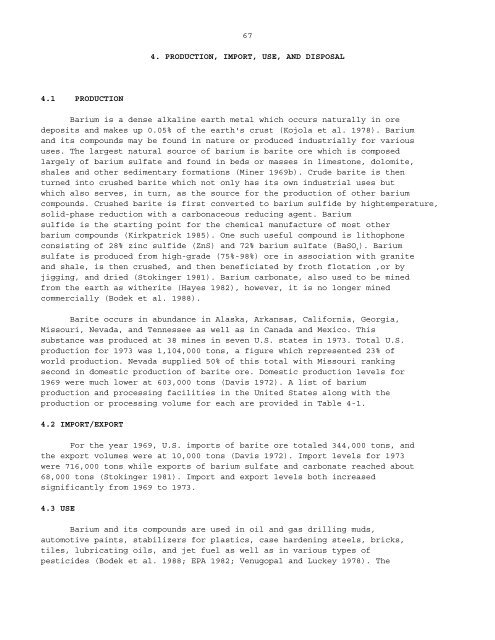TOXICOLOGICAL PROFILE FOR BARIUM AND COMPOUNDS ...
TOXICOLOGICAL PROFILE FOR BARIUM AND COMPOUNDS ...
TOXICOLOGICAL PROFILE FOR BARIUM AND COMPOUNDS ...
Create successful ePaper yourself
Turn your PDF publications into a flip-book with our unique Google optimized e-Paper software.
67<br />
4. PRODUCTION, IMPORT, USE, <strong>AND</strong> DISPOSAL<br />
4.1 PRODUCTION<br />
Barium is a dense alkaline earth metal which occurs naturally in ore<br />
deposits and makes up 0.05% of the earth's crust (Kojola et al. 1978). Barium<br />
and its compounds may be found in nature or produced industrially for various<br />
uses. The largest natural source of barium is barite ore which is composed<br />
largely of barium sulfate and found in beds or masses in limestone, dolomite,<br />
shales and other sedimentary formations (Miner 1969b). Crude barite is then<br />
turned into crushed barite which not only has its own industrial uses but<br />
which also serves, in turn, as the source for the production of other barium<br />
compounds. Crushed barite is first converted to barium sulfide by hightemperature,<br />
solid-phase reduction with a carbonaceous reducing agent. Barium<br />
sulfide is the starting point for the chemical manufacture of most other<br />
barium compounds (Kirkpatrick 1985). One such useful compound is lithophone<br />
consisting of 28% zinc sulfide (ZnS) and 72% barium sulfate (BaSO 4<br />
). Barium<br />
sulfate is produced from high-grade (75%-98%) ore in association with granite<br />
and shale, is then crushed, and then beneficiated by froth flotation ,or by<br />
jigging, and dried (Stokinger 1981). Barium carbonate, also used to be mined<br />
from the earth as witherite (Hayes 1982), however, it is no longer mined<br />
commercially (Bodek et al. 1988).<br />
Barite occurs in abundance in Alaska, Arkansas, California, Georgia,<br />
Missouri, Nevada, and Tennessee as well as in Canada and Mexico. This<br />
substance was produced at 38 mines in seven U.S. states in 1973. Total U.S.<br />
production for 1973 was 1,104,000 tons, a figure which represented 23% of<br />
world production. Nevada supplied 50% of this total with Missouri ranking<br />
second in domestic production of barite ore. Domestic production levels for<br />
1969 were much lower at 603,000 tons (Davis 1972). A list of barium<br />
production and processing facilities in the United States along with the<br />
production or processing volume for each are provided in Table 4-1.<br />
4.2 IMPORT/EXPORT<br />
For the year 1969, U.S. imports of barite ore totaled 344,000 tons, and<br />
the export volumes were at 10,000 tons (Davis 1972). Import levels for 1973<br />
were 716,000 tons while exports of barium sulfate and carbonate reached about<br />
68,000 tons (Stokinger 1981). Import and export levels both increased<br />
significantly from 1969 to 1973.<br />
4.3 USE<br />
Barium and its compounds are used in oil and gas drilling muds,<br />
automotive paints, stabilizers for plastics, case hardening steels, bricks,<br />
tiles, lubricating oils, and jet fuel as well as in various types of<br />
pesticides (Bodek et al. 1988; EPA 1982; Venugopal and Luckey 1978). The
















